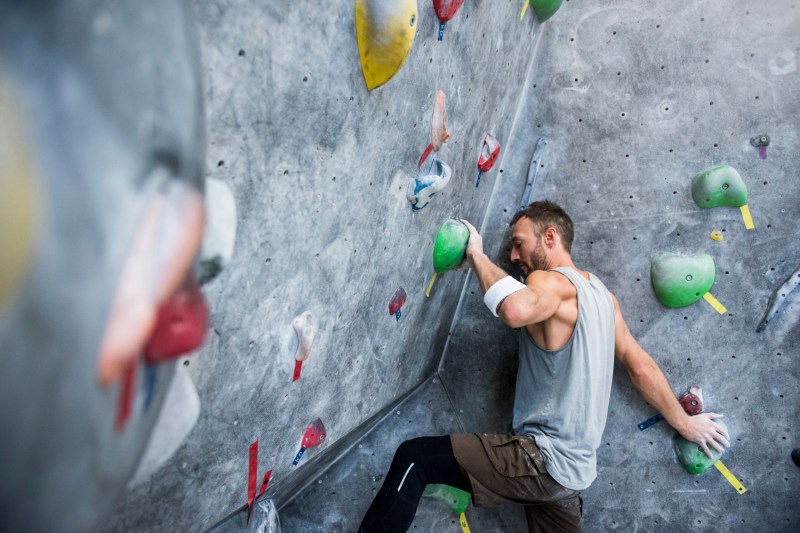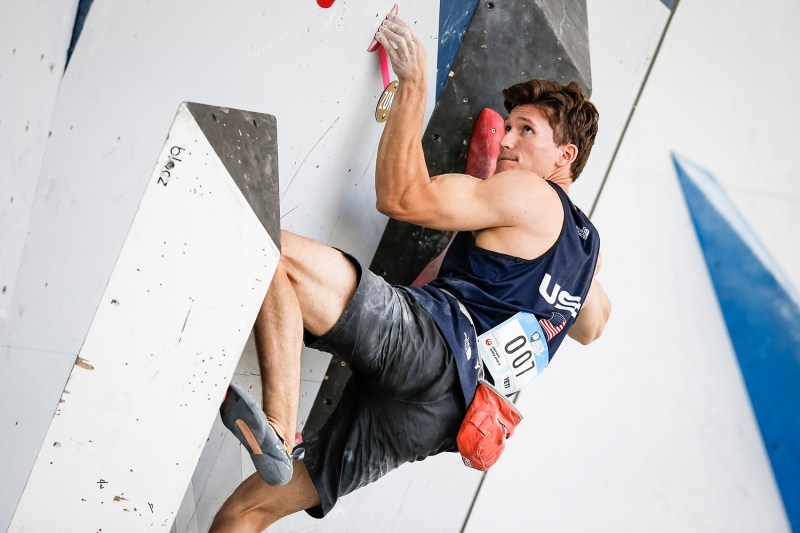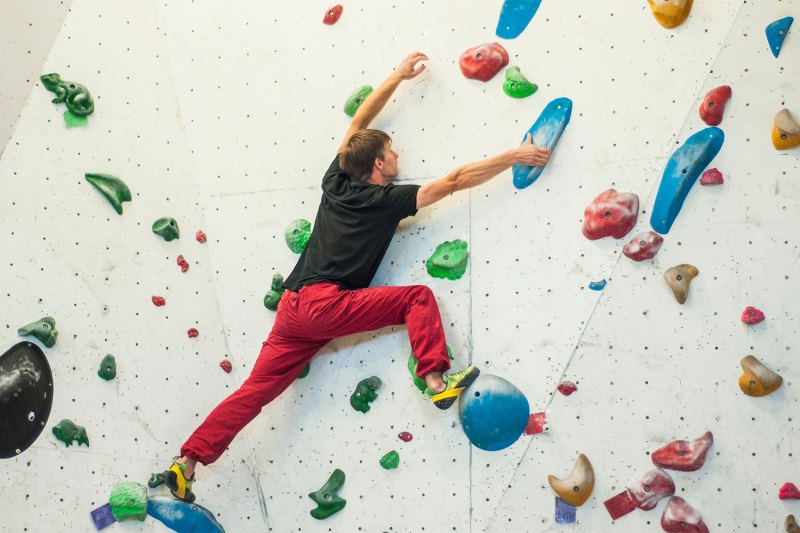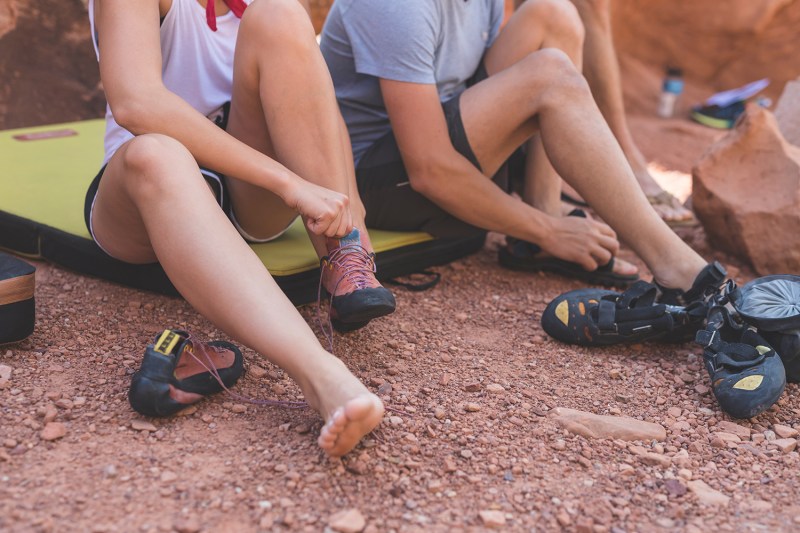
Rock climbing can be a little intimidating, with all the steep inclines, ropes, and requisite knots. But we’re not all trying to free solo El Capitan like Alex Honnold. Many of us just want to get some quality exercise somewhere other than the weight room.
Bouldering is a tremendous full-body workout that’s fun, improves balance and agility, and requires relatively little in terms of gear. It’s a type of rock climbing, but is generally rope-free, meaning you don’t have to learn how to belay. As such, there’s often more lateral movement than vertical, but it’s wonderfully demanding all the same. Keep reading to learn how to boulder.

How to boulder as a beginner
Find a route: Start easy if you’ve never climbed before. At the bouldering gym, getting started is as easy as finding a route. At most bouldering centers, the routes are color-coded by level of difficulty. The easier routes will have larger holds and less demanding aspects. As you work your way up, you’ll notice the holds get smaller, more spread out, and tend to cover trickier rock faces and inclines.
Chalk up: Get comfortable chalking while you’re climbing as you’ll want to keep your palms as blister-free as possible. Practice dunking each hand into the bag, leaving the other hand available for stability.
Rest: Rest is key, especially when you start to take on longer routes that involve 30, 50, or 100 or more holds. Take advantage of spots on said routes where you can relax at least most of your body either by balancing or wedging yourself in position.
Practice routes: Going through a route mentally is a great way to plan your attack at the gym. Imagine where your major limbs will go as you move from hold to hold. Soon, your trained eyes will see the smallest of outcroppings and dents in the rock as places you could clasp onto. And nobody is going to dock you points early on if you don’t stick fully to the route map. Use all the holds you need early on until you get a feel for it.

Observe other climbers
Learn from those around you. There will always be bouldering gym rats; just don’t let them get under your skin. Typically, the best climbers in the building are young kids, with little body weight and natural agility. Watch others, ideally those similar in size, as they navigate routes. Watch the detailed hand and footwork and try to replicate it as best as you can on your own.
It’s a blast to attack a route in pairs and can be a learning experience, as it’s rare for two climbers to approach a route in exactly the same way. Alternate with a friend or stranger at the gym, taking advantage of the frequent rests, as you try to crack the code. And study at home with instructional videos like this.

Embrace the awkward
Bouldering is not the most comfortable sport, but the exhilaration alone is worth the price of admission. The shoes are uncomfortable (they should be tight enough that your toes curl some for a better, talon-like grip) and your legs and arms get beat up. Sometimes you’re completely inverted, while other times your arms are twisted up and you feel locked in position. Embrace all of it. You have to get comfortable with being in strange positions while bouldering. Knowing that the discomfort is temporary will lead to greater victories.
Learning how to fall is part of the equation. Practice pushing off the wall and landing in squat form on the ground or pad below. Springing off is often important, as it can protect you from getting caught on any holds on the way down. You don’t have to stick the landing but you’ll surely want to keep your legs bent to soften the impact.

Become stronger and more flexible
Flexibility can make all the difference as you ascend to new bouldering heights. Stretch often and learn the limits of your limber body. Knock out at-home exercises and stay disciplined so that you actually begin to experience some results. Work on all major muscle groups, as bouldering demands pretty much the entire body. But focus especially on your core, calves, forearms, and shoulders.
To build or maintain finger strength when you’re not bouldering, use a stress ball or something with a fair deal of tension. It’s a mindless task you can carry out while knocking out some work from home or at the office, which will do wonders for your grip.

Gear
A few things you’ll need as you embark on your adventures in bouldering:
- Chalk bag
- Tight-fitting climbing shoes
- Comfortable clothing
- Athletic tape
- A good water bottle
- Hand salve

Can you boulder by yourself?
If you’re not able to get a group going to boulder and opt to go by yourself, make sure you’re taking the necessary precautions. For those looking to go out and boulder in the wild, the gear requirements are a bit different. Without a padded floor at your service, you’ll likely need a crash pad you can tote along with you. A nylon brush is good to have to clear off potential holds and lighting (as in a headlamp) is great if you’re climbing until late or in cavernous areas with less natural light.
There are training boards you can set up at home to help you fine-tune your skills. And if you’re feeling really ambitious, build your own DIY wall. It’s a good home project and it’ll save you the fees from the actual bouldering gym.

Can you boulder outside?
Absolutely. There are great spots to boulder all over the country, and chances are good that you can find them online or through a new pal at the bouldering gym. When bouldering outside, you’ll likely need a few extra pieces of equipment, namely a pad to fall on when that foot or hand slips. A decent first-aid kit is a good thing to have on hand and pack some extra snacks as you’re going to burn a lot of calories. Practice falling in a way that protects your head, and seek out known routes, as they’re likely to be much more stable, and therefore, safer for you to play around on.
Thinking about other activities that involve a bit of adventure? Check out our guide to fly-fishing and our feature on how to surf. You’ll be having a blast with a new hobby in no time.
Editors' Recommendations
- Mountain bike gift guide: 12 fantastic ideas for the mountain biker in your life
- Snowboarding gear gift guide: SMITH, Burton, 686, Dakine, and more
- The complete snowboard buying guide and size chart
- The ultimate ski helmet and snowboard helmet guide: MIPS, Koroyd, WaveCel, and which helmet protects best
- Snowboarding for beginners: How to conquer the dreaded chairlift without falling



